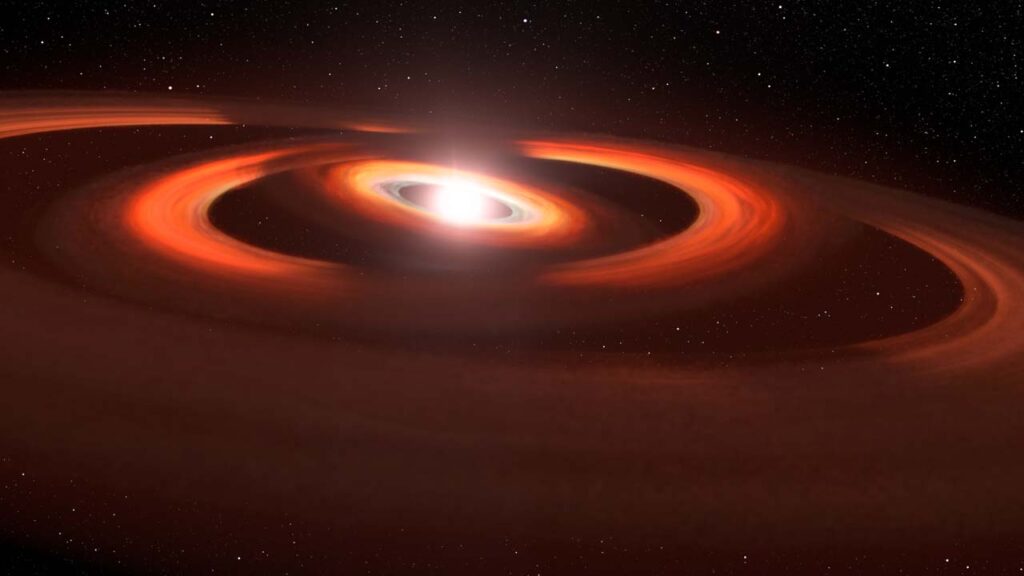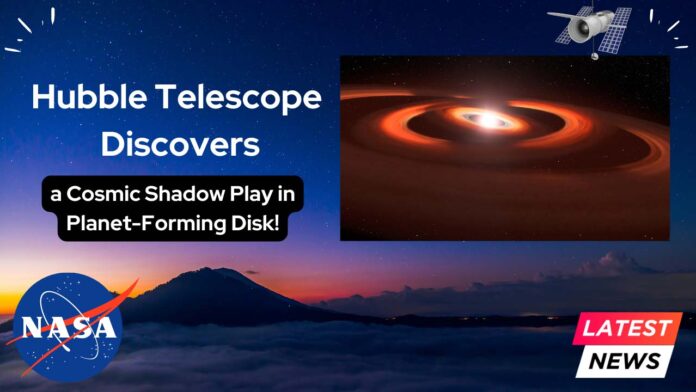The Hubble Space Telescope has made a significant discovery in the field of astronomy. NASA’s iconic telescope has detected a shadow play around a planet-forming disk, providing insights into the early stages of planetary systems. The observation of the cosmic shadow play was made on the disk surrounding the T Tauri star, V1247 Orionis, 1,350 light-years away. This discovery has opened up new possibilities in the study of planet formation and has the potential to unlock secrets about the evolution of our own solar system.
Shadow Play Around Planet-Forming Disk
The discovery of shadows moving around the planet-forming disk around V1247 Orionis is a significant breakthrough in our understanding of planet formation.

Hubble Space Telescope
The Hubble Space Telescope is one of NASA‘s most significant contributions to astronomy. It has provided us with unprecedented views of our universe.
V1247 Orionis
The T Tauri star V1247 Orionis is 1,350 light-years away from Earth and is located in the constellation Orion.
The Disk Surrounding V1247 Orionis
The disk surrounding V1247 Orionis is approximately 5 million years old and is 10 times larger than our solar system.
How the Shadows were Detected
The Hubble Space Telescope detected the shadows moving around the disk using its Advanced Camera for Surveys and Wide Field Camera 3 instruments.
Understanding Planet Formation
The discovery of the shadow play around the planet-forming disk is providing scientists with new insights into the early stages of planetary systems.
Key Facts about Planet Formation
Planets form from dust and gas in a disk. Planetesimals collide and merge to form planets, and gravity plays a key role in planet formation.
Importance of the Discovery
The discovery of the shadow play around the planet-forming disk has the potential to unlock secrets about the evolution of our own solar system and the search for extraterrestrial life in the universe.
Research by RIT Scientist
An RIT scientist played a significant role in the research, analyzing the shadow patterns to determine the size of the dust particles.
Future of Astronomy
The discovery of the shadow play around the planet-forming disk opens up new possibilities for the study of planet formation and the evolution of our solar system.
Everything You Need to Know About Lunar Eclipse – History, Facts, and How to Watch it
What the shadows tell us about planet formation
- The shadows suggest the presence of objects in the disk that are growing and interacting with the surrounding material.
- The movement of the shadows indicates that there are multiple objects in the disk, which could be planetesimals or even small planets.
- The shadows provide scientists with new insights into the dynamics of planet formation and the early stages of planetary systems.
- The observations of V1247 Orionis are important because they allow scientists to study the early stages of planet formation in a way that is not possible with most other planet-forming disks.
The role of dust and gas in planet formation
- Dust and gas are the building blocks of planets.
- The dust and gas in a planet-forming disk clump together to form planetesimals, which are small, rocky bodies that are the precursors to planets.
- The planetesimals then collide and merge to form larger and larger bodies, eventually leading to the formation of planets.
- The dust and gas in a planet-forming disk also plays a crucial role in shaping the orbits of planets and determining their final positions within a planetary system.
Key Facts about Planet Formation
| Fact | Explanation |
|---|---|
| Planets form from dust and gas in a disk | The dust and gas in a disk clump together to form planetesimals, which eventually form planets |
| Planetesimals collide and merge to form planets | The larger planetesimals collide and merge to form larger and larger bodies |
| Gravity plays a key role in planet formation | Gravity helps to pull together the dust and gas in a disk, as well as shaping the orbits of planets |
Conclusion:
The discovery of shadows moving around the planet-forming disk around V1247 Orionis is a significant breakthrough in our understanding of planet formation. The observations provide scientists with new insights into the early stages of planetary systems and shed light on the complex processes involved in the formation of planets. This discovery will undoubtedly pave the way for further research into planet formation and the search for extraterrestrial life in the universe.

